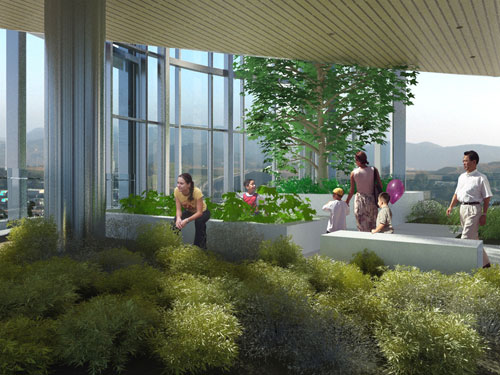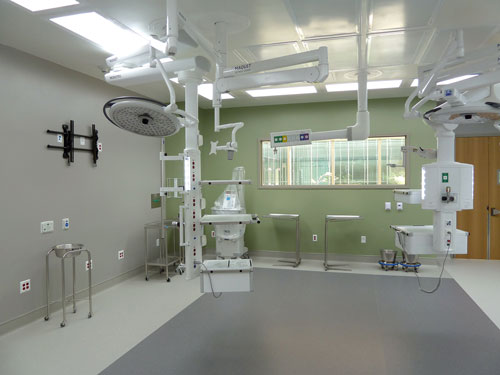Nature Nurtures
For Lunder’s skylit atrium, MVVA selected a robust vine species with 20-foot-long tendrils to emphasize the space’s verticality and developed an integrated irrigation system. But before the facility’s opening, the owner replaced the live vines with silk facsimiles, citing maintenance and infection-control concerns.
 |
Palomar’s patient tower includes garden terraces planted with ferns, flowers, and shrubs. To create double-story spaces tall enough for trees in these gardens, the design team has staggered the tower’s floor plates. Rendering courtesy CO Architects |
Both hospitals have exterior envelopes detailed so that the occupants can derive maximum benefit from the buildings’ natural (or natural-looking) features. For instance, Palomar’s unitized curtain wall system includes fixed exterior shading louvers that prevent uncomfortable glare conditions, allowing patients to keep the operable interior shades open, except when complete darkness is desired. The louvers also mitigate heat gain, making them an important part of the building’s energy conservation strategy—a strategy expected to enable Palomar to perform about 10 percent better than California’s energy code, Title 24. Hospitals, which are often notorious energy consumers, are exempt from Title 24 and therefore are not required to comply, points out Moore.
At Lunder, the patient-room levels are clad in full-height insulated glazing units. These units’ lower lites include a frit that provides a perceptual edge, while allowing light to bounce off the floor. At the top edge of the room the ceiling tapers, with the glazing extending above the typical 9-foot room height. This detail ensures the maximum view of the exterior environment, even for bed-bound patients, explains Siebenmorgen.
Straightforward but thoughtful details, like the Lunder patient-room soffits or the Palomar sunscreens, belie the complexity of the buildings’ programs, mechanical and structural infrastructure, and architecture. Both project teams credit their successful coordination of these overlapping systems to their use of building information modeling (BIM). “Now this is pretty standard stuff,” says Siebenmorgen. But in 2005, when design work at Lunder and Palomar kicked off, use of BIM was not yet widespread.
The teams depended on BIM for tasks such as exploring program alternatives, better understanding site constraints, virtually simulating construction, and coordinating trades. They also used it to help design challenging geometric conditions, like the staggered garden terraces in Palomar’s patient tower, dictated by the projects’ biophilic goals.
 |
The hospital’s operating rooms, housed in a two-story wing for diagnosis and treatment, have windows that provide medical staff with views into courtyards. Photo © Tom Bonner |








